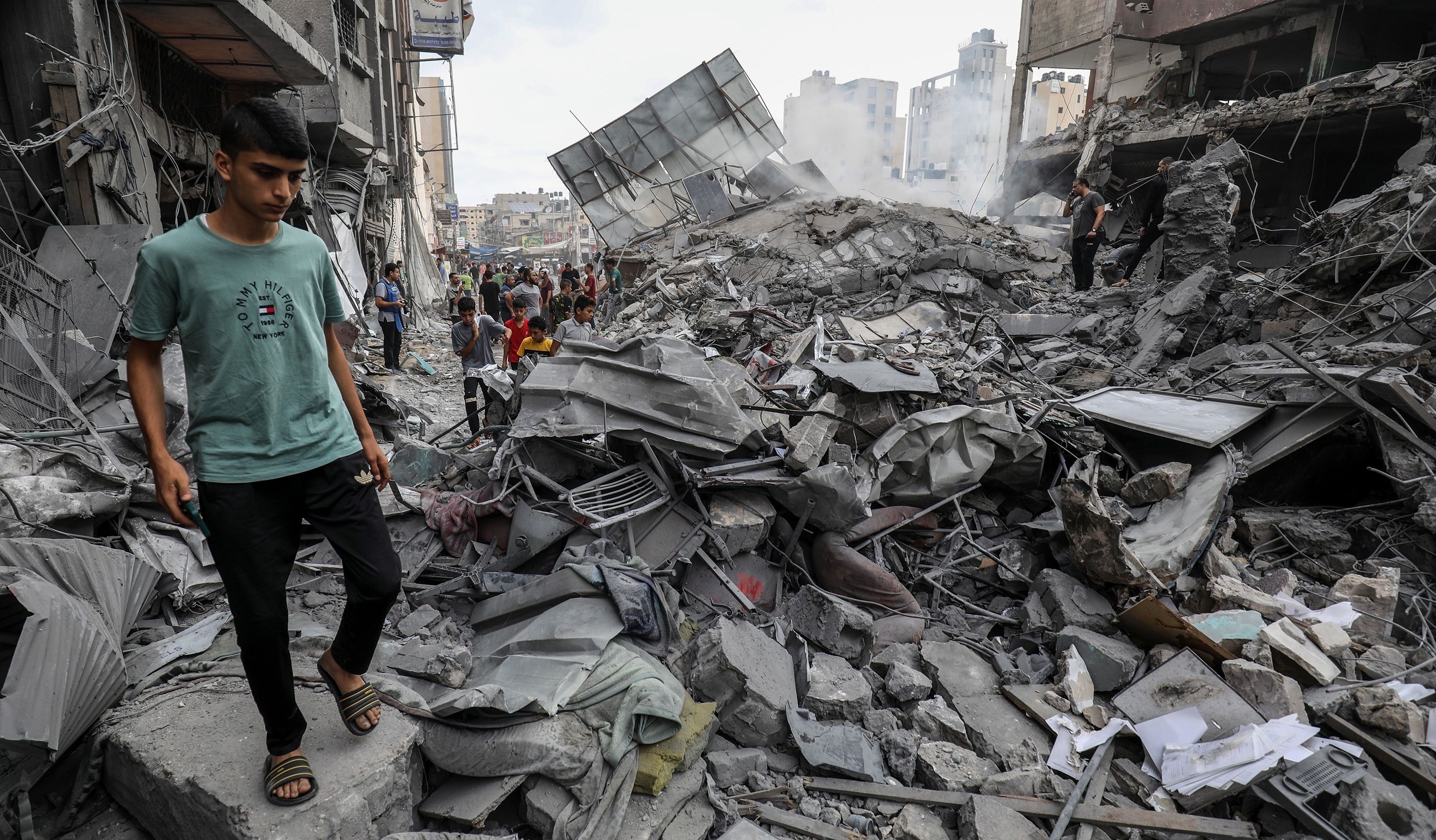The absence of any viable plan for governing the Gaza Strip after the Israeli military’s devastation of the territory has increasingly been noted by puzzled commentators both here and abroad.
That absence is remarkable in view of the scale of the Israeli military assault and the carnage it has caused. The number of Palestinians in Gaza whom Israeli attacks have killed has now passed 10,000. One would have to go back to the fighting in 1948 — in what Israelis call their war for independence and Palestinians call the Nakba — to see a Palestinian death toll of comparable magnitude.
The Biden administration seems to have spent nearly all of its considerable time and attention on this crisis in trying first to exude support for Israel and then, in the face of the lethal Israeli assault on Gaza — which in one month has killed more children than have been killed in all the conflicts in the world in any full year since 2019 — saying it is trying to restrain Israeli excesses. It has said very little about what should, or will, come after the bloodshed in Gaza.
Secretary of State Antony Blinken, in a press appearance after a recent G7 meeting, mentioned several criteria for post-war Gaza, including no blockade or siege, no reoccupation, no reduction of the territory, and no use of it as a base for terrorism. Those criteria are reasonable but left unanswered basic questions about exactly who would govern the Gaza Strip and how.
In response to questions, Blinken later said that Gaza should be united with the West Bank under the Palestinian Authority (PA), which under the Israeli military occupation performs limited functions in portions of the West Bank. This vision is infeasible for multiple reasons, chief of which is that the PA, as the obsolete residue of what was supposed to have been a five-year transitional arrangement after the 1993 Oslo Accords, is widely unpopular among Palestinians. Fatah, which controls the PA, lost to Hamas in the last Palestinian election in 2006. Since then, the PA has become increasingly discredited as little more than a security auxiliary to the Israeli occupation.
It is questionable whether the PA and its president, Mahmoud Abbas, would even want to assume such responsibilities. The chaos and destruction following the Israeli assault on the Gaza Strip would present an enormous challenge for any governing body, and to be seen riding into Gaza, figuratively speaking, on the back of an Israeli tank would discredit the PA further in the eyes of many Palestinians.
Moreover, successive Israeli governments under Benjamin Netanyahu have striven to prevent any leader or body from being able to speak for Palestinians in both Gaza and the West Bank. Netanyahu went so far in the past as to channel Qatari money to Hamas as a rival to the PA, and to withhold tax revenues from the PA whenever it showed any sign of reconciling with Hamas. Such divide-and-rule tactics were all in the interest, as Netanyahu told a meeting of his Likud party, of preventing the establishment of a Palestinian state and sustaining Israel’s argument that it has no “negotiating partner” for creating such a state.
Netanyahu himself has so far been no more specific about postwar arrangements than Blinken. He has merely said that Israel probably will retain “security responsibility” for the Gaza Strip for an indefinite period.
The absence of a feasible and specific post-war plan for the Gaza Strip is even less excusable with Israel itself than with the United States, given that Israel is the one inflicting the current devastation, but that absence may be more comprehensible. The ongoing assault is in large part a matter of uncontrolled rage and revenge following Hamas’s brutal attack in southern Israel on October 7. When Isaac Herzog, who occupies Israel’s largely ceremonial presidency and is a relative moderate in Israeli political terms, says there are “no innocent civilians in Gaza” and that the entire Palestinian nation is “responsible” for what happened on October 7, this reflects how much sheer rage and unfocused hatred are driving Israeli policies — which is not an environment conducive to careful advance planning.
The notion that “destroying Hamas” must take overriding priority and be accomplished before any cease-fire, or even serious planning about what comes after, misinterprets the source of any future security threats to Israeli citizens emanating from Gaza. It also is a prescription for unending war in Gaza.
Hamas is much more than the military wing that perpetrated the atrocity of October 7. It is both the de facto civil administration of a territory of some two million people, and a nationalist movement whose goal has always been the establishment of a Palestinian state with an Islamist tint. If Hamas really could be “destroyed” — and as a movement and a nationalist aspiration that is impossible — that would leave huge questions about the day-to-day administration of the Gaza Strip, on matters ranging from health care to electrical power generation.
The Israelis assert that their bombardment, with sometimes 300 or 400 sorties in a day, is carefully directed at what the Israelis call “terrorist targets” rather than the civilian life of Palestinians. That assertion is not credible, given the sheer breadth and scale of the resulting destruction, statements such as Herzog’s that reveal the operation to be collective punishment of the Palestinian people, the opacity of Israel’s targeting process, and the fact that the security services that are doing the targeting are the same ones that missed Hamas’s October 7 attack.
A result is that the assault may be causing even more damage to what is needed for administration of the Gaza Strip than to would-be perpetrators of more armed violence against Israel. As Nathan Brown of George Washington University observes, with the political wing of Hamas being a softer target than the military wing, “There is a significant possibility that the military wing will actually increase its hold on the organization — and that it will identify any postwar governance that targets the movement as collaboration with Israeli efforts to eliminate it.”
Discussions have begun within the U.S. government and elsewhere about a possible international peacekeeping or other presence in Gaza, but any such arrangements would address only the short term and involve limited services. Even a special-purpose international presence might be difficult to arrange. With United Nations Secretary General Antonio Guterres reporting that 92 people working with the U.N. agency that serves Palestinian refugees having been killed by Israeli attacks in the Gaza Strip, any hesitation about an expanded U.N. role there would be understandable. Arab states in the region would be reluctant to take on responsibilities in Gaza for the same general reasons as the Palestinian Authority. Any U.S. or Western presence, especially given Western policies supporting the Israeli war, would be seen by many as another form of foreign occupation.
No matter how hard Israel tries to “destroy” Hamas, Israeli citizens will not be secure from violence connected to Gaza until and unless Israel permits self-determination by the Palestinian people. And no matter how vehemently one condemns the condemnable atrocity that Hamas perpetrated on October 7, it is still just as true that this was no piece of evil that came out of the blue but instead was a violent manifestation of anger very much related to decades-long occupation, blockade, and subjugation of one nation by another.
Now, in addition to that long-brewing resentment is the additional anger from Israeli violence that has brought a Palestinian death toll to five figures within one month, in addition to immense other suffering in the Gaza Strip. If Hamas in its present form is somehow destroyed, future violent manifestations of that anger will come from some other form of Hamas, or from other groups or individuals. As former U.S. ambassador to Israel Daniel Kurtzer notes, “Because it is a movement, rather than a standing army, Hamas understands that for every fighter killed and for every civilian killed, it will be able to recruit new militant adherents.”
Lately, Israeli officials have tried to rationalize the civilian casualties from their attacks by recalling the civilian casualties from U.S. and allied operations in past wars, such as from bombing against Germany in World War II and the dropping of atomic bombs against Japan. The intended implication is that sometimes many innocents need to be killed to get a successful military result leading to a better and more peaceful future.
But this Israeli analogy omits a crucial piece of political follow-up. After the allies’ military victory and initial post-war occupations, the independent German Federal Republic was created in 1949, and full sovereignty was restored to Japan three years later.
Imagine an alternative history in which the U.S. occupation of Japan continued indefinitely, with the Japanese denied political rights and any say in how their nation was managed. Imagine further that the occupation included pushing many Japanese off their land and replacing them with American settlers, and confining other Japanese to an open-air prison subject to a suffocating blockade. Violent resistance, including many forms of terrorism, would be the certain result.
That alternative would be the true analogy to what has been taking place for years in Palestine, including Gaza, and that will continue to transpire in the absence of any plans, better than what has been voiced so far, for what should follow the current assault. It is a future of perpetual warfare. And it is a future that the United States is helping to sustain unless it uses its economic and diplomatic leverage to add teeth not only to its calls for Israeli restraint in the current round of warfare but also to its ritual invocation of the need for a long-term political resolution of the Israeli-Palestinian conflict.- The warfare of starvation - Responsible Statecraft ›
- Biden has the leverage to stop the war in Israel - Responsible Statecraft ›
- The Palestinian Authority isn’t going to save Gaza - Responsible Statecraft ›
















